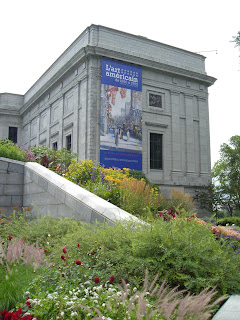Posted by Brian T. Allen, The Mary Stripp & R. Crosby Kemper Director
With the Addison construction project nearing its close, so, too, is the Addison’s traveling exhibition, Coming of Age, which features seventy of our greatest paintings and sculptures. The show’s “grand tour” began at the Addison in the fall of 2006 and subsequently traveled to the Meadows Museum in Dallas, the Dulwich Picture Gallery in London, the Peggy Guggenheim Collection in Venice, and the Fort Lauderdale Museum of Art. The show is currently installed at its final venue, the Museum of Fine Arts in Quebec City, where it closes on September 7th. A richer tour is hard to imagine.
The show was a landmark in so many different ways – as the most visited summer show in Italy last year, the first survey show of American art in Quebec, and the United Kingdom’s first true retrospective of American art made from the mid-nineteenth century through its triumph on the international stage a century later. Coming of Age provided tremendous publicity and visibility for us while our doors in Andover were closed. Only a few days after it opened in London, all the major London papers – the Telegraph, the Guardian, the Times, the Financial Times, the Independent (see right) – devoted lavish and positive reviews to the show, some running a full page. This was amazing given all the things happening in the London arts scene. Many of the critics seemed genuinely surprised to find so much that was new and original about American art. Only Brian Sewall, the art critic for the Evening Standard, veered from the consensus that the show was truly wonderful and a revelation. Sewall’s review was so invective-ridden that I found myself chuckling by the time I finished it. He is a notorious contrarian and I suppose he needed to tell the other critics why they were all wrong. Even a bad review has its upside, though, since the full page of illustrations brought even more people to see the show.
Only a few days after it opened in London, all the major London papers – the Telegraph, the Guardian, the Times, the Financial Times, the Independent (see right) – devoted lavish and positive reviews to the show, some running a full page. This was amazing given all the things happening in the London arts scene. Many of the critics seemed genuinely surprised to find so much that was new and original about American art. Only Brian Sewall, the art critic for the Evening Standard, veered from the consensus that the show was truly wonderful and a revelation. Sewall’s review was so invective-ridden that I found myself chuckling by the time I finished it. He is a notorious contrarian and I suppose he needed to tell the other critics why they were all wrong. Even a bad review has its upside, though, since the full page of illustrations brought even more people to see the show.

The show was beautifully installed in every venue. It was great to see our things installed by different curators in different ways, and each installation expressed the vision they saw in the show, different audiences, different spaces, and varying design sensibilities. When the art is great, there are infinite ways to interpret it.
And so the great Homers, Eakinses, Hoppers, the remarkable Pollock, Stella and O’Keeffe will soon be taken off the walls in Quebec, packed and on their way back to Andover, in time to join the other wonderful objects in the Addison’s permanent collection on view at the gallery’s public reopening celebrations next year. I am looking forward to seeing you there!
Tuesday, September 8, 2009
Coming of Age – Coming Home to Andover
Posted by
Addison Gallery of American Art
at
6:00 AM
![]()
Subscribe to:
Post Comments (Atom)
1 comment:
We saw the show, and went to the talk by the curators, in the Museum of Art of Fort Lauderdale. It was beautifully presented, and for me, a very emotional reunion with these paintings. Each painting was both a memory, and a revelation. I was seeing them through the eyes of a teenager, as I first saw them, wandering around the second floor of the Addison, in the 1960's; and also as an adult, and parent, seeing them as masterpieces of American Art, in the context of history.
Standing in front of Eight Bells, with my son who started at PA this fall, I understood why this iconic painting has become so loved by so many of us; It shows two sailors, in an wild and endless ocean, working together to learn and use the skills needed to navigate their ship, and their lives. That is us. That is Andover.
Post a Comment